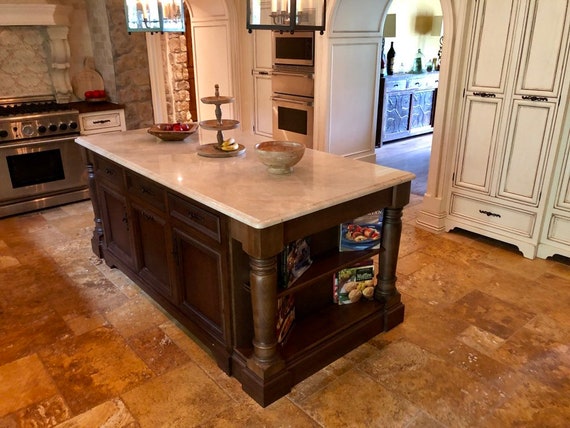The Best Kitchen Island Leg Options for Modern and Typical Kitchens
The Best Kitchen Island Leg Options for Modern and Typical Kitchens
Blog Article
The Value of a Sturdy Kitchen Island Leg in Creating a Useful Cooking Area
A durable kitchen island leg serves as a basic part in developing a practical cooking environment, giving essential assistance for both the counter top and different kitchen area activities. As kitchens develop into multifunctional locations for food preparation, eating, and interacting socially, the selection of materials and design factors to consider for island legs becomes significantly important.
Benefits of Sturdy Island Legs
Offering important support, strong cooking area island legs play an essential role in boosting the capability and toughness of cooking area islands - kitchen island leg. These legs not just bear the weight of the countertop and any additional items put on the island, but likewise add to the total stability of the structure. A well-supported cooking area island makes sure that it continues to be practical and upright, even under hefty usage, which is specifically vital in active kitchen area environments
Moreover, strong island legs can enhance the aesthetic allure of the cooking area. They provide a solid framework that can enhance different design styles, from contemporary to typical. This adaptability enables homeowners to customize their kitchen area islands according to individual preference while guaranteeing that the architectural honesty continues to be uncompromised.
In enhancement to their helpful function, robust kitchen area island legs can additionally boost safety and security. Ultimately, investing in durable kitchen area island legs is essential for a functional and visually pleasing cooking area.
Materials for Kitchen Area Island Legs
When choosing materials for kitchen area island legs, resilience and visual allure are critical aspects to consider,. One of the most usual materials include hardwood, metal, and engineered timber, each offering one-of-a-kind benefits.
Hardwood, such as oak, cherry, or maple, is a classic option because of its stamina and timeless appeal (kitchen island leg). It can stand up to significant weight and is immune to wear, making it perfect for high-use kitchen area environments. In addition, hardwood can be stained or repainted to complement various cooking area designs
Metal legs, often crafted from stainless steel or wrought iron, offer a commercial and modern look. They are extremely solid and can support considerable loads while being resistant to dampness and heat, which is beneficial in a cooking location. Metal legs can also be conveniently cleaned up, enhancing their practicality.

Style Considerations for Security
The choice of products for kitchen area island legs directly affects the design factors to consider for stability. When designing a kitchen island, it is paramount to review the weight-bearing capability of the picked products. Larger materials, such as strong wood or metal, generally give higher security, specifically under the tension of day-to-day use.
In addition, the leg design have to incorporate correct geometry to enhance security. A wider base raises the support location, minimizing the threat of tottering or tipping. Consideration needs to likewise be provided to the elevation of the legs; out of proportion leg lengths can lead to imbalance, jeopardizing the general stability of the island.
Moreover, the distribution of weight across the island is vital. Ensuring that the leg placement aligns with the heaviest components, such as kitchen counters and appliances, will certainly further improve stability.
Upkeep Tips for Durability

Depending on the product of the legs-- whether wood, metal, or composite-- ideal cleaning methods need to be employed. Steel legs may call for a light polish to protect against corrosion and keep their radiance.
Additionally, tightening screws and bolts consistently can ensure stability and avoid wobbling. Consider strengthening the legs with additional braces or sustains to enhance longevity if the kitchen area island experiences hefty use. Using a safety finish or sealant can guard versus dampness and discolorations, prolonging the life-span of the legs. By adhering to these maintenance tips, property owners can ensure their cooking area island legs stay useful click reference and robust for many years to come.
Picking the Right Leg Design
Routine maintenance ensures that cooking area island legs continue to be strong and useful, however selecting the right leg style is just as important for both visual appeals and assistance. The selection of leg design can dramatically influence the overall style and consistency of your cooking area.

Performance is another important element. For instance, thicker legs or those with a sturdy base can sustain much heavier counter tops and equipment, boosting the island's energy. Alternatively, slender legs may create an airy look, ideal for lighter styles but potentially less encouraging.
Verdict
In recap, the significance of durable kitchen area island legs can not be overemphasized in the creation of a practical cooking location. These legs give crucial assistance, enhance stability, and contribute to the overall visual of the kitchen area. By very carefully choosing proper materials and styles, in addition to implementing proper upkeep techniques, the durability and efficiency of kitchen islands can be ensured. Inevitably, spending in robust island legs is fundamental to attaining a reliable and secure cooking environment.
A strong kitchen area island leg serves as a basic component in developing a useful food preparation atmosphere, offering required support for both the kitchen counter and different cooking area tasks.Supplying necessary assistance, strong kitchen island legs play a pivotal duty in improving the performance and sturdiness of kitchen islands. Eventually, investing in sturdy kitchen area island legs is important for a practical view it and aesthetically pleasing cooking area.
Consideration needs to likewise be offered to the elevation of the legs; disproportionate leg lengths can lead to discrepancy, jeopardizing the total stability of the island.
Wooden legs give warmth and a classic appearance, while metal legs use a contemporary and commercial feeling.
Report this page